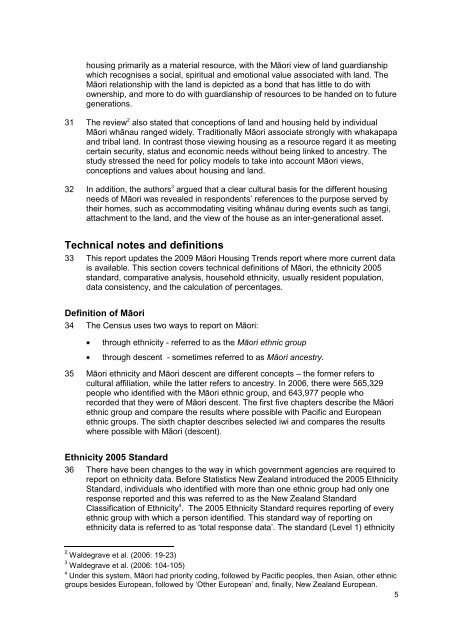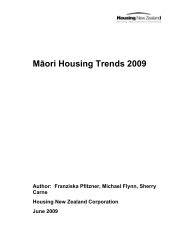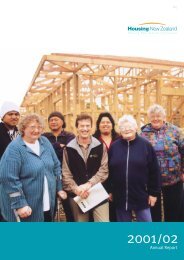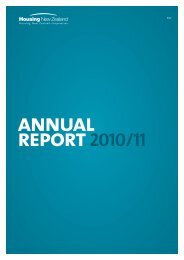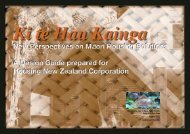MÄori Housing Trends 2010 - Housing New Zealand
MÄori Housing Trends 2010 - Housing New Zealand
MÄori Housing Trends 2010 - Housing New Zealand
Create successful ePaper yourself
Turn your PDF publications into a flip-book with our unique Google optimized e-Paper software.
housing primarily as a material resource, with the Māori view of land guardianshipwhich recognises a social, spiritual and emotional value associated with land. TheMāori relationship with the land is depicted as a bond that has little to do withownership, and more to do with guardianship of resources to be handed on to futuregenerations.31 The review 2 also stated that conceptions of land and housing held by individualMāori whānau ranged widely. Traditionally Māori associate strongly with whakapapaand tribal land. In contrast those viewing housing as a resource regard it as meetingcertain security, status and economic needs without being linked to ancestry. Thestudy stressed the need for policy models to take into account Māori views,conceptions and values about housing and land.32 In addition, the authors 3 argued that a clear cultural basis for the different housingneeds of Māori was revealed in respondents’ references to the purpose served bytheir homes, such as accommodating visiting whānau during events such as tangi,attachment to the land, and the view of the house as an inter-generational asset.Technical notes and definitions33 This report updates the 2009 Māori <strong>Housing</strong> <strong>Trends</strong> report where more current datais available. This section covers technical definitions of Māori, the ethnicity 2005standard, comparative analysis, household ethnicity, usually resident population,data consistency, and the calculation of percentages.Definition of Māori34 The Census uses two ways to report on Māori:• through ethnicity - referred to as the Māori ethnic group• through descent - sometimes referred to as Māori ancestry.35 Māori ethnicity and Māori descent are different concepts – the former refers tocultural affiliation, while the latter refers to ancestry. In 2006, there were 565,329people who identified with the Māori ethnic group, and 643,977 people whorecorded that they were of Māori descent. The first five chapters describe the Māoriethnic group and compare the results where possible with Pacific and Europeanethnic groups. The sixth chapter describes selected iwi and compares the resultswhere possible with Māori (descent).Ethnicity 2005 Standard36 There have been changes to the way in which government agencies are required toreport on ethnicity data. Before Statistics <strong>New</strong> <strong>Zealand</strong> introduced the 2005 EthnicityStandard, individuals who identified with more than one ethnic group had only oneresponse reported and this was referred to as the <strong>New</strong> <strong>Zealand</strong> StandardClassification of Ethnicity 4 . The 2005 Ethnicity Standard requires reporting of everyethnic group with which a person identified. This standard way of reporting onethnicity data is referred to as ‘total response data’. The standard (Level 1) ethnicity2 Waldegrave et al. (2006: 19-23)3 Waldegrave et al. (2006: 104-105)4 Under this system, Māori had priority coding, followed by Pacific peoples, then Asian, other ethnicgroups besides European, followed by ‘Other European’ and, finally, <strong>New</strong> <strong>Zealand</strong> European.5


